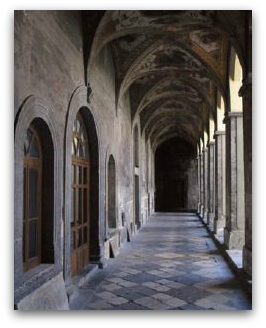
- Interior
The first construction dates back to the XII century by Oriental monks. The church was rebuilt in 1301 and suffered further transformations in the XIV century; it was modified and adorned in the XVII and XVIII centuries. An hallway leads to the entrance; the interior consists of a single aisle with side chapels.
The Baroque decoration (1755-56) is a Nicola Tagliacozzi Canale's work who drew plasters, polychrome marbles and wooden carvings.
Above the entry a grand organ can be admired. In the aisle there are two statues: the statue of St. Michael the Archangel by Girolamo Santacroce on the right, the funeral monument dedicated to Corradino of Swabia on the opposite side. Under the triumphal arch, within a tosello, a wooden crucifix is preserved (second half of the XIV century).
According to tradition, in 1439, during the Aragonese siege, the Christ on the cross lowered his head dodging a bullet.
In the chapels there are canvases by Mattia Preti, Giovanni Sarnelli, Matteo Bottigliero, Francesco De Mura, Francesco Solimena, Antonio Sarnelli and others.
In the presbitery, in four niches, there are some urns in Oriental alabaster.
The altar is a work of Giuseppe Mazzetti. The Chapel of the "Vergine del Carmelo", called also "La Bruna" ("the dark-haired woman") leads to the sacristy. The painting depicting the Virgo and Her Child is located in a marble aedicule by Bartolomè Ordonez, with Prophets, Angels and Resurrection.
The Sacristy presents wooden closets by G. B. Bisogni and frescoes by Filippo Falciatore, representing Saints of the "Carmelitani".
Under the monumental bell tower, the only cloister is accessible. Other two cloisters were demolished for the widening of Via Marina.